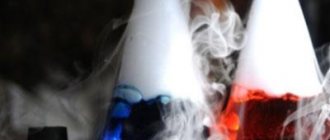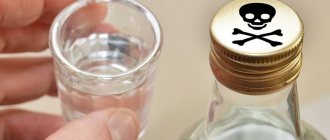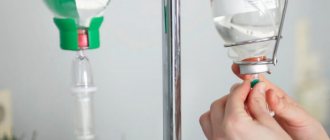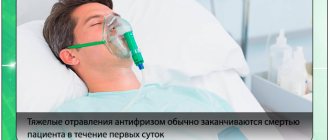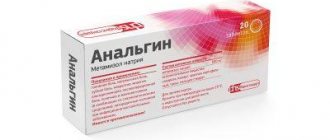Corvalol is an affordable remedy for lowering blood pressure and normalizing heart rate. It is also indicated for excessive irritability, insomnia and vegetative-vascular dystonia. The drug is available in the form of tablets and drops. Outside the former USSR, the German analogue, Valocordin, which has an almost identical composition, is better known.
Corvalol poisoning can occur as a result of an accidental or intentional overdose: it is often prescribed to elderly patients who find it difficult to monitor regular intake due to forgetfulness and vision problems. It is even more difficult to calculate the dosage of medication if the condition suddenly worsens. If the recommended norm is constantly exceeded, the patient develops chronic intoxication and dependence on the drug.
How long does Corvalol last in urine?
It is almost impossible to determine exactly how long the components of Corvalol will be present in the patient’s urine. This fact is explained by the fact that the rate of elimination of drug substances from the human body can be influenced by various factors, including the following:
- The performance of the urinary system. Since barbiturates are excreted from the body primarily through the kidneys with urine, the length of time Corvalol remains in the body will depend on the condition of the urinary system. For example, if a patient has nephritis or pyelonephritis, the rate of elimination of the drug components will be significantly reduced.
- General health. Even without deep knowledge of anatomy, anyone can conclude that the speed of metabolic processes and the level of immunity are directly dependent on the duration of the removal of Corvalol compounds from the urine. Naturally, in poor health, the components of the drug remain in the body for a longer time.
- Duration of use and dosage of the product. Long-term use of Corvalol in doses exceeding the permissible values increases the period of content of the drug components in urine. Therefore, if it is necessary to take a test for barbiturates, the patient should stop taking the medication at least 7-14 days before the test.
Numerous studies have found that, on average, the duration of the medication in urine ranges from 2 to 45 days. So, within 2-4 days the components of the substance can be detected in urine with a single use of Corvalol. Systematic use of the drug over a long period of time leads to the detection of barbiturates in urine for up to one and a half months. The elimination of the drug can be accelerated by taking large amounts of fluid and diuretics.
- Around the clock
- Anonymously
- For free
Why is a bottle of Corvalol dangerous for a driver?
Some drivers have heart problems or are very nervous. To calm down, many people buy Corvalol or Valocordin at the pharmacy, especially since a doctor’s prescription is not needed for this purchase. After 20 drops of medicine, it would seem that you can get behind the wheel! In fact, this is far from the case. The medicine bottle brings a surprise! And not the most pleasant one.
To find out everything, read the instructions for Corvalol. It states that the drug contains phenobarbital. It increases the influence of other components, reduces excitation of the central nervous system and facilitates the process of falling asleep. The manufacturer also warns to be careful when driving the car, as reaction speed and attention are noticeably reduced.
Now let’s clarify how long it takes for phenobarbital to be removed from the body. Completely excreted by the kidneys in 8 days
.
What if you take 20 drops of Corvalol or Valocordin on an empty stomach, and even without getting enough sleep? It is clear that the examination will show the presence of phenobarbital metabolites in the urine.
After all, who will wait until 8 days have passed after drinking 20 drops of medicine? Probably no one will. Although I think they would have waited if they had read the instructions more carefully.
Phenobarbital is a drug that is prohibited for drivers. It turns out that you will break the law if the examination shows the presence of a prohibited substance in your urine.
The fact that you only drank 20 drops of Corvalol or Valocordin will not worry anyone, believe me.
Even if someone throws themselves under the wheels of your car or crashes into you, you will still be recognized as the culprit of the accident if a prohibited substance is detected in your blood. So then prove that you are not a turkey.
Don’t be sure that if the breathalyzer shows zero, the inspector will definitely let you go. The inspector can still send you for a medical examination if he suspects another state of intoxication.
For example, pale skin, unstable posture, inappropriate behavior and other reasons. And in the hospital, an analysis will show the content of the prohibited substance phenobarbital in the urine.
Here are 20 harmless drops of Corvalol for you!
But since July of this year, criminal liability has been introduced for drunk driving and the fine rises to 300 thousand! A driver who simply drank Corvalol or Valocordin risks being left without his last pair of pants or even ending up behind bars. There will be very little chance of winning in court even with a good lawyer.
I advise you to carefully read the instructions even for those drugs that are sold without a prescription, and not to drive until the substance is completely eliminated from the body.
Well, now let’s talk about such a common means of calming as smoking one or two cigarettes. Just think, what's wrong with that, smoking is not a hindrance to driving. It turns out that this is not the case.
You risk it if you get behind the wheel immediately after smoking. The breathalyzer can show the presence of alcohol if tobacco smoke enters it.
But you don’t want problems, so after smoking, it’s better to wait about five minutes before driving, and don’t forget to rinse your mouth with water.
What to do if the inspector finally stopped you, immediately after you smoked or while smoking while driving? If he offers to undergo a test, you have every right to refuse and request a referral for a medical examination. The inspector must draw up a referral protocol, give you a copy and take you to the clinic.
Let's say you're in a hurry and don't want to go to the hospital to get checked. Then be sure to make sure that the breathalyzer has an intact state verification stamp, a verification certificate and an entry in the technical passport. A disposable sealed mouthpiece must be used and must not be wiped with any liquid before use.
Make sure that the brand, model and serial number of the device are indicated in the report. If they do not show the passport for the device, record this in the act. Be sure to request a printout of the examination results. Check whether the date and time of testing and the serial number of the device are on the printout.
If the device shows the presence of alcohol, do not panic. Be sure to record your disagreement with the protocol and lack of intoxication. Request a copy of the protocol and resolution, making sure that the text can be read. Insist on undergoing a medical examination.
I advise you not to give in to the inspector’s demands to undergo an on-site inspection. Don’t risk it, it’s much safer to do it in a clinic. Entrust the examination to doctors working in clinics and having the appropriate licenses. Make sure that the doctor draws up the report without corrections, cross-outs or abbreviations, signs, stamps and registers it in the Registration Book.
Know your rights and do not allow anyone to violate them, including traffic police inspectors. And be careful about what you consume when you get behind the wheel.
Good luck on the road!
Source: //ShkolaZhizni.ru/auto/articles/71720/
How long does Corvalol stay in the blood?
The half-life of the drug from plasma in adults is 53-118 hours (average 79 hours). Based on the data presented, we can conclude that the drug will completely leave the body in about 5-8 days.
You can find out how much of the drug is currently in the blood through a special study. No preparation is required for the test. The analysis is aimed at identifying barbiturates in biological material. The minimum content of phenobarbital in the blood when taking Corvalol is considered to be the norm.
Why did the Corvalol test show barbiturates?
Do not be surprised if, during a study on the content of Corvalol in the blood or urine, the test showed the presence of barbiturates in the body. The presence of this kind of substance is explained by the fact that the medication contains phenobarbital, a derivative of the barbiturate group, which can have an anticonvulsant and sedative-hypnotic effect.
Phenobarbital belongs to the group of narcotic drugs, since its long-term use can cause the formation of persistent addiction, comparable even to alcohol dependence. Moreover, it is worth noting the fact that an overdose of a substance leads to the development of intoxication of the body and can cause death.
There is no need to be afraid if the study revealed minimal levels of phenobarbital in the body. The permissible level of the substance in urine is up to 1000 ng/ml, and when Corvalol is used only for medicinal purposes, this indicator will never exceed the threshold values.
Prevention
To prevent poisoning by this substance, you need to follow a number of recommendations:
- strictly follow the dosage prescribed by the doctor;
- do not combine Corvalol with alcoholic beverages;
- do not increase the duration of therapy on your own;
- combine Corvalol with other drugs only with a doctor’s permission;
- if there are disturbances in the functioning of the nervous system, the patient’s relatives should monitor the drug intake.
An overdose of Corvalol is observed quite often and is the result of various factors. To avoid such problems, it is very important to strictly follow all medical recommendations. If poisoning does occur, you should immediately call an ambulance.
Paradox
Copyright © Itogi Magazine
The editors do not have the opportunity to enter into correspondence, as well as review and return manuscripts and illustrations that they have not ordered. The editors are not responsible for the content of advertising materials. When reprinting materials and using them in any form, including in electronic media, as well as on the Internet, a link to the “Results” is required.
Removal of barbiturates from the body after taking Corvalol (1)
They told me to come back in two days and repeat.
Indeed, I took Corvalol, not knowing what kind of mess I could get into with it.
On the Internet I only found the removal of barbiturates in a hospital setting for poisoning.
Accordingly, the question is how to quickly remove leftovers at home?
And how to control it?
half-life 2-4 days
if at home = drink plenty of fluids only..
The elimination of, for example, barbiturates can be accelerated by introducing bicarbonate salts into the body, which cause alkalinization of urine.
half-life 2-4 days
Based on the accuracy of the test, this is a year.
The accuracy of the test was determined by latent assays with the following barbital content in the samples: 150, 225, 375, 450 ng/ml, respectively.
(I just went through) 1250 rubles, nothing was found.
Accordingly, the question is how to quickly remove leftovers at home?
Drink plenty of fluids + diuretics. Now is the time to eat watermelons
2. if, due to suspicions, etc., sensitive methods (SME) are used, then you can try bemegride: 10 ml of 0.5% solution intravenously, 3-4 injections.
read toxicological chemistry.
this is not a good option, narrow-minded ordinary people will start using furosemide, lose potassium and get a bunch of problems..
quote: what other medicines can show that “camel”? (I just went through) 1250 rubles, nothing was found.
This means you consumed something for which there is no test yet
So you used
this is not a good option, narrow-minded ordinary people will start using furosemide, lose potassium and get a bunch of problems
quote: Originally posted by ryururu:
2. if, due to suspicions, etc., sensitive methods (SME) are used, then you can try bemegride: 10 ml of 0.5% solution intravenously, 3-4 injections.
ryururu Be careful with the recommendations. Bemegrid is an analeptic, has a direct stimulating effect on the respiratory (to a lesser extent on the vasomotor) center, which leads to an increase in the frequency and amplitude of respiratory movements. It has clear indications for use. respiratory arrest NB. against the background of an overdose of barbiturates, thiobarbiturates and other drugs for general anesthesia. To terminate anesthesia with barbiturates and thiobarbiturates, to accelerate awakening during general anesthesia. Severe hypoxia. NB!
And contraindications Hypersensitivity, psychomotor agitation, epileptic syndrome.
quote: Originally posted by ryururu:
read toxicological chemistry.
Read, yes, but before you give advice, you still need to think carefully. what to advise and in what cases. Bemegrid is not needed in this particular case. Why ? . Read the instructions for use of the drug again.
The appearance of convulsive twitching of the limbs serves as a signal to stop administering the drug.
Depends on the initial ionogram and the dose of the drug.
Furosemide and Panangin in the mouth, Lasix in the mouth. Although lasis is furasemide.
In large doses, esentuki-4 with soda and potassium chloride bufus.
I'll go today and buy some tests.
I'll go today and buy some tests.
+ a couple of good watermelons. Good luck .
Soda, please comment.
In your specific case, for the task at hand, you do not need to use soda.
Depends on the initial ionogram and the dose of the drug.
No, well, it’s clear that I meant an initially healthy person who does not plan to attempt suicide with the help of furosemide. 2-3 diuretic tablets during the day cannot lower the potassium level to any dangerous level.
It is useless to try to remove barbiturates from the body using “some kind of accelerated method”; they are lipid-soluble and deposited in adipose and brain tissue. I would not recommend doing any experiments.
The body itself, in its own way, gets rid of them.
Removal of barbiturates from the body after taking Corvalol (1)
Not only those who have been poisoned by these drugs, but also those who are forced to take them as prescribed by a doctor should know how to completely remove barbiturates from the body.
Barbiturates are a group of drugs derived from barbituric acid, psychotropics and anticonvulsants that depress the nervous system and are prescribed as anticonvulsants, sedatives, and hypnotics. Depending on the dose, the drugs provide effects ranging from mild sedation to anesthesia. They are used for epilepsy, chorea, insomnia, and a number of nervous diseases.
Now barbiturates are used to a limited extent and, if possible, are replaced by other drugs of similar action due to the high risk of overdose, intoxication or addiction, including drug addiction. In pharmacies, most of these products are sold strictly by prescription.
Any driver can be recognized as a drug addict
Alexey Smirnov, candidate of pharmaceutical sciences, head, told us an incredible story.
chemical and toxicological laboratory of the Moscow Scientific and Practical Center for Narcology. Traffic cops brought a citizen who was stopped for a medical examination because his SUV was driving... on three wheels. One fell off a little earlier, and the poor driver, in his words, simply did not feel it. The inspectors did not assess the stability of the car, immediately doubting the condition of the car owner. We didn’t smell any signs of alcohol intoxication, but something told us that our friend needed to be tested for drugs.
Laboratory analysis showed the result (in the Russian Federation such tests are carried out on urine): phenobarbital - more than 40 thousand nanograms (ng) per 1 milliliter (1 ng is one billionth of a gram)! For reference: the therapeutic concentration of phenobarbital in human blood is considered to be 5–40 thousand.
nanograms per milliliter of blood, and a reading of 100–200 nanograms is considered fatal.
At the trial, the citizen assured that, having become nervous during the arrest, on the way to the medical examination he drank heart drops, which are known to be sedatives. A toxicologist chemist present as a witness doubted: a decent single dose of 50 drops of Corvalol or Valocordin gives up to 3000 ng/ml in the analysis. It is doubtful that the “patient” would have taken almost ten times more...
We’ll return to exposing the phenomenon later (the details are important for our topic), but one thing can be said: the driver took the substance specifically for medicinal purposes.
Execution cannot be pardoned?
“The provisions on drug intoxication in the “driving” article of the Code of Administrative Offenses need to be edited in order to eliminate the trap hidden in it,” says Alexey Smirnov. — It is even more important to compare the situation associated with the use of certain medications and food products with the realities of life.
Only a specialist will notice the trap in Article 12 of the Administrative Code: “Note. The use of substances that cause alcohol or drug intoxication, or psychotropic or other intoxicating substances (emphasis added) is prohibited. Administrative liability arises in the case of the presence of narcotic drugs or psychotropic substances in the human body.”
Let's treat the text corrosively, like a judge when considering, for example, your, God forbid, “corvalol” case. Pharmaceuticals are classified as “other substances that cause intoxication.”
They appear in the first part of the note - here they are put on the same level as drugs and psychotropic drugs. But at the end of the note, “other substances” are no longer mentioned.
It turns out that it’s impossible, it’s impossible, but after taking heart drops, administrative responsibility does not seem to arise.
It’s too early to rejoice: the result of a drug examination was attached to the court case; it contains, albeit a tiny, but positive indicator. And the law does not allow these substances in the analysis in the slightest dose (as with the bad memory of the anti-alcohol zero threshold). Guess three times: what decision will the court make?
Special instructions: read!
The driver himself can avoid an unfair verdict. And not by forgery - it won’t work.
The author of these lines was shown only one device in action: with its help, it is determined at a distance and in an instant whether the client has presented his own urine (drug addicts carry a jar of moisture from a virgin baby in their pocket in case of examination).
Bound by a non-disclosure obligation, the author is not entitled to reveal more. Toxicologists said that they were equipped with other ingenious devices, but refused to even describe them.
This device determines nanograms. With it, the influence of the “human factor” is completely eliminated - the process is completely automated, computerized, the operating mode is 24 hours a day. This device determines nanograms.
With it, the influence of the “human factor” is completely eliminated - the process is fully automated, computerized, operating hours are 24 hours a day.
The driver can help himself in other ways. When your doctor first writes a prescription, ask if the medicine will cause the same side effects.
In fact, the doctor himself should warn about them, but suddenly he forgets... If you bought the drug without a prescription, in the instructions for it, don’t be too lazy to go through, at least diagonally, the “Special Instructions” section. You will come across the words “not recommended for drivers”, “...working with machinery”, etc. - note.
It is even more reliable to look at the composition of the medicine - it may contain names that are useful for any driver to know, as well as to understand what they threaten.
From the instructions for "TeraFlu". From the instructions for "TeraFlu".
And don’t blindly trust what you “have been accepting all your life,” but have once read the instructions. Components appear in the preparations that do not reduce the effect of the main action, but give new manifestations in nuances. The nuance may relate to the driver's protection from unintentional confrontations with the law.
We provide consultation: at the end of the material there is a list of Dr. Smirnov. It contains the most common medications that cause a positive result in a toxicological analysis.
Why they are dangerous - using examples of well-known drugs.
...and three days without a steering wheel
Let's finish the topic with phenobarbital - it is included in many popular drugs. This type is cunning and insidious: it can hide in the body for a long time, moreover, accumulate. If you took the same Valocordin or Corvalol in the evening, especially if twice (in the most usual doses - 30-40 drops), then you can’t drive the next day: phenobarbital will disappear only on the third day.
In its pure form, this healing substance is absolutely incompatible with driving a car. In the amazing story with the “three-wheeled” SUV, the defendant made it clear to the medical witness (not in the courtroom - in the corridor) that in fact he did not take Valocordin - he underwent a course of treatment with pure phenobarbital. So 40 thousand nanograms have accumulated.
It would seem that a recent government decision classified it as a psychotropic substance and thereby limited its circulation - it has become extremely popular among drug addicts. (Nevertheless, on the Internet they openly offer to buy it in its pure form for 220 rubles per package. However, this is another topic.
) But up to two hundred types of medicines containing it remain freely available. In a number of drugs (say, painkillers), phenobarbital acts as a component in the composition of substances, and in this case it is not considered prohibited.
But even if you call it a pot, it does not lose its ability to linger in the body and is easily detected by chemical-toxicological analysis.
When overwork, insomnia, or just need to get enough sleep, many grab the well-known lifesavers - the publicly available phenazepam, donormil, diphenhydramine.
If, when going to bed, you take one of them, and the next morning they check you for some reason, then, well-rested and alert, they will tell you: “A state of intoxication has been established.”
The laboratory will definitely find sleeping pills, and the narcologist will write something in the report about tremor, nystagmus and redness of the eyes...
But I just dripped...
Do you like morphine?
Even more dangerous are the components of drugs, which, being harmless in themselves, serve as raw materials for the “production” of drugs, Aleksey Smirnov pointed out. The name of the neoplasms is metabolites. The location of their “production” is the “chemical laboratory” of the human body. The pedestrian is aware of these chemical metamorphoses, but not the driver.
Source: //www.zr.ru/content/articles/575858-lubogo_voditela_mogut_priznat_narkomanom/
Poisoning" and overdose
Most often, barbiturate poisoning occurs due to an overdose of these drugs. This is possible in the following cases:
- intentionally taking a large dose at once (suicide attempt);
- due to an unauthorized increase in the dose or duration of administration for a greater therapeutic effect (when the patient feels that the drug is not helping him enough);
- for the sake of achieving a drug high (in 80% of cases this leads to death).
In rare cases, intoxication can occur due to taking expired or improperly stored medications.
Also, poisoning is possible not only with strong drugs of the barbituric group, sold strictly by prescription. It is often necessary to withdraw barbiturates after taking Corvalol, Andipal, Sedalgin-neo or Valocordin. These drugs are sold freely, but contain phenobarbital.
Acute barbiturate poisoning leads to coma, respiratory failure and death. In addition, the functioning of the cardiovascular system is disrupted:
- vascular tone decreases;
- myocardial contractility deteriorates;
- Venous and blood pressure drops.
As a result of cardiac dysfunction, the following symptoms develop: hypoxia occurs, body temperature decreases, and the amount of urine excreted decreases to a critical level.
Overdose and poisoning with barbiturates always entail serious consequences in the form of mental disorders, pulmonary or cerebral edema. If a poisoned person is forced to remain motionless for a long time after poisoning without proper care, this risks the development of bedsores.
Poisoning is divided into stages: falling asleep, superficial and deep coma. The latter often causes the death of the poisoned person.
The lethal dose of barbiturates is very small. For example, only 2–10 g of Phenobarbital is enough for an adult, after which it is almost impossible to save the victim.
Dose information
Many people use the drug Corvalol. It comes in the form of tablets or drops.
The medication contains phenobarbital and menthol. The first ingredient is used to prevent seizures in patients with epilepsy. Corvalol contains a minimal amount of phenobarbital. It is prescribed for the following conditions:
- the presence of situations associated with increased nervous excitability;
- problems falling asleep;
- systematic panic attacks;
- tension of the nervous system.
Bromine, included in Corvalol, can provoke negative manifestations in the form of skin rashes of an allergic nature, heart slowdown, drowsiness and other problems associated with the functions of the central nervous system.
How long does it take to eliminate barbiturates?
It is useless to look for quick ways to remove barbiturates from the body. The duration of this process will never be the same for everyone. Removal time always depends on a number of factors:
- amount of dose taken;
- duration of treatment;
- human body weight;
- how well the kidneys function (since barbiturates are excreted primarily in the urine);
- speed of metabolic processes in the body.
On average, the half-life of these drugs can take 2.5–4 days. It will be possible to completely remove barbiturates from the body no earlier than within 4 to 8 days, but again depending on the listed factors affecting the rate of elimination.
Also, how quickly barbiturates can be removed is influenced by the speed of medical care. If the team was called immediately and the doctors immediately began taking measures to cleanse the body of excess drugs, the process of removing them will be easier. However, it will take time to remove the drugs not only from the stomach and intestines, but also from the blood and urine.
Factors
- Using too much of the drug. Stress during which people use Corvalol can cause a state of shock. As a result, a person loses the ability to control his own actions. He knows that he needs to drink 10-15 drops of the product, but to achieve a pronounced effect, he is able to consume a whole bottle or more.
- Presence of mental disorders. To calm his condition, a person deliberately exceeds the recommended dosage. This should not be allowed, because the medicine must be taken according to the doctor’s instructions.
- If the drug is used by a minor patient, an overdose may occur due to the characteristics of the child’s body. Therefore, dosages for this group of patients must be selected individually.
- The risk of developing intoxication increases in diseases accompanied by impaired renal function. Elderly patients should take Corvalol with extreme caution.
- Death often occurs when the drug is combined with alcohol. In this case, significant depression of the central nervous system and deterioration in motor coordination occurs.
Exceeding the dosage of Corvalol can cause death. Negative consequences can be avoided by following medical instructions.
How to remove barbiturates
Since barbiturates are strong psychotropics, you cannot do without special medications in case of poisoning with them.
Drug removal
Arriving at the hospital after poisoning, the poisoned person will receive first aid, which is always prescribed for intoxication: gastric lavage with a special probe, sorbents, laxatives, etc. But in the case of barbiturates, this is not enough, so the patient will be prescribed procedures and drugs to remove them and restore the body after suffering stress.
- Gastric lavage with a solution of sodium bicarbonate, potassium permanganate or a suspension of activated carbon using a probe.
- Sodium thiosulfate as an antidote (there is no specific antidote to barbiturates, so this drug is used to bind poisons in the intestines and provide a laxative effect with the subsequent removal of psychotropics to the outside).
- Diuretics to force diuresis (they are given to conscious patients to drink, otherwise the drugs are administered intravenously).
- For faster elimination - intravenously, subcutaneously or with an enema, 3-4 liters of 5-10% glucose solution or sodium chloride.
- In case of severe poisoning - hemodialysis.
In case of poisoning and overdose with barbiturates, symptomatic treatment is also carried out based on the patient’s condition, when the effect of individual drugs is aimed at normalizing the functioning of certain organs. However, sodium thiosulfate as an antidote and diuretics are necessary for the body to flush the body and cleanse it of psychotropic drugs.
Breeding using traditional methods
Since barbiturates are actively excreted in the urine, treatment methods should be selected that would help in this direction.
How to remove barbiturates using folk diuretics:
- Bearberry leaves (bear's ear) - 3 parts, cornflower flowers - 1 part and licorice root - 1 part. Mix the ingredients, pour one tablespoon of the mixture with a glass of boiling water, leave, cool and strain. You need to drink this herbal diuretic tea 3-4 times a day, 1 tablespoon.
- Pour a glass of boiling water over lingonberry leaf (20 g) and leave. Drink a tablespoon three times a day.
- Pour rosehip (3 tablespoons of dried fruit) with a liter of boiling water. Leave for 12 hours and drink before meals 3 times a day.
- Dill seeds - 1 tsp. pour a glass of boiling water, leave for 20 minutes and drink 2 tablespoons. l. three times a day.
Helping the body eliminate Phenobarbital and other barbiturates at home should be done carefully. Most prescriptions have their own contraindications, so it is better to discuss the advisability of this with your doctor before taking it.
Treatment
Regardless of the severity of an overdose of Corvalol, the victim requires qualified medical care. First of all, you need to call an ambulance, and then rinse the patient’s stomach. For this purpose, a person needs to drink 1 - 1.5 liters of water, and then induce vomiting artificially. The procedure is repeated until clean wash water is obtained.
Cleansing the intestines with an enema will help improve your well-being. The patient is recommended to drink more water, preferably mineral water. It is advisable to take enterosorbent: activated carbon or Smecta, Enterosgel. The dosage of the sorbent is determined by the patient’s body weight.
In case of intoxication of 2 or 3 degrees of severity, when lethargy develops or the patient loses consciousness, lavage of the gastrointestinal tract is contraindicated. The victim is placed on his back, his head turned to the side. The room should be fresh. Constrictive clothing must be unbuttoned and wait for the ambulance team to arrive.
You also need to check your pulse. It may not be palpable on the arm, which is explained by reduced blood pressure. The best option is to place your fingers on the carotid artery in your neck. If the pulse disappears, you should immediately begin closed cardiac massage.
Upon arrival, doctors administer the antidote intravenously to the patient - Bemegride, which neutralizes the effect of phenobarbital. In case of moderate or severe poisoning, the patient is hospitalized in a hospital, where complex therapy is carried out. The patient is prescribed detoxification therapy in the form of intravenous infusions of glucose-saline solutions and plasma substitutes.
If necessary, cardiac or respiratory stimulants and diuretics are used. If spontaneous breathing is impaired, the patient is connected to a ventilator. Hemodialysis is possible if blood pressure is normal.
In case of an overdose of Corvalol, it is important to undergo full treatment, relieve signs of intoxication and thereby improve the general condition of the patient.
If the diagnosis of an overdose of Corvalol is confirmed, treatment is prescribed:
- If you drink a lot of tablets or drops, rinse your stomach. Rinse using a special gastric umbrella.
- In case of acute and chronic poisoning, symptomatic therapy is prescribed. Helps quickly restore impaired functions of the cardiovascular and respiratory systems.
In case of respiratory failure: treatment involves tracheal intubation and a ventilator is connected.
It is worth noting that treatment in this case is carried out by a toxicologist, narcologist, and also a psychotherapist.
How to remove barbiturates from urine
You can check whether there are barbituric drugs in the urine using special tests. If they turn out to be positive, it is necessary to urgently begin removing psychotropics.
It is possible to completely remove barbiturates from urine, but this will not happen earlier than after 4–7 days. But much will depend on the duration of taking psychotropic medications and their dose. To speed up elimination, the patient should drink more and receive diuretics orally or otherwise:
- osmotic diuretic Mannitol 5–10% intravenously, 200–500 ml for several hours;
- saline solution (in case of unconsciousness, intravenously 2–3 liters per day);
- glucose, sodium chloride intravenously.
In addition to medication, you can use folk remedies, but only with the permission of a doctor.
>
Symptoms
Signs of poisoning directly depend on the amount of medicine taken. There are several degrees of intoxication. In simple cases, the following symptoms are observed:
- absentmindedness;
- weakness;
- weakening of muscle tissue;
- drowsiness;
- speech problems.
Symptoms of a moderate overdose of Corvalol include the following:
- prolonged sleep - it is very difficult to remove the poisoned person from this state;
- weakness of muscle tissue - can even lead to paresis;
- excessive saliva production;
- pressure drop;
- dilated pupils;
- decrease in the volume of urine excreted.
Contraindications
Due to the alcohol content, the drug may be prohibited in the presence of chronic stages of diseases of the liver, kidneys, and brain. Alcoholism is classified as a strict contraindication.
Valocordin (Corvalol) is prohibited for use by children (under 18 years of age) and pregnant (nursing) women, people with allergic reactions. The interaction of alcohol and phenobarbital threatens serious poisoning.
Valoserdin is a drug in the form of drops. The components of the product are phenobarbital (2 g) and ethyl bromizovalerianate (2 g) in 100 ml. The liquid is colorless and has a light aroma of peppermint, hops and oregano.


